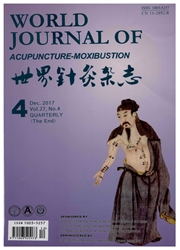

 中文摘要:
中文摘要:
目的:观察艾灸对膝骨性关节炎患者疼痛、僵硬、功能障碍等症状的疗效,评价艾灸疗法的有效性和安全性。方法:59例膝骨性关节炎患者随机分为艾灸组(31例)和安慰艾灸组(28例),分别将治疗艾炷和安慰艾炷粘贴在内膝眼、犊鼻、阿是穴处给予艾灸治疗,每次每穴3壮,隔日1次,每周3次,连续治疗6周,统计治疗3周、6周时的疗效,并于治疗结束后6周对患者进行随访。采用骨关节炎调查量表(WOMAC)、46 m最快步行时间评价关节功能恢复情况,使用UT-325数字温测仪记录膝关节疼痛最明显的治疗点艾灸前后温度变化。结果:艾灸组治疗3周、6周及随访时WOMAC量表各项评分均明显降低(P〈0.05,P〈0.01,P〈0.001);安慰艾灸组随访时僵硬评分较治疗前降低(P〈0.05);治疗6周及随访时,艾灸组较安慰艾灸组疼痛、僵硬、功能障碍评分下降更明显(P〈0.01,P〈0.05)。艾灸组治疗6周后46 m最快步行时间较治疗前明显缩短(P〈0.01),而安慰艾灸组治疗后改善不明显(P〉0.05),组间比较差异无统计学意义(P〉0.05)。艾灸组艾灸后治疗点温度为(49.81±3.10)℃,安慰艾灸组为(40.98±1.67)℃,两组均较治疗前局部皮肤温度明显升高(P〈0.001,P〈0.01),艾灸组温度升高更明显(P〈0.001)。结论:艾灸可明显改善膝骨性关节炎患者疼痛、僵硬、功能障碍等临床症状,是一种安全、有效的治疗方法。
 英文摘要:
英文摘要:
Objective To observe the therapeutic effect of moxibustion on pain, stiffness and physical dysfunction caused by knee osteoarthritis (KOA), and make an assessment on the effectiveness and safety of this therapy. Methods Fifty-nine cases of KOA were randomly divided into a moxibustion group (31 cases) and a sham-moxibustion group (28 cases). The treatment of moxibustion was given at Nèixīyǎn (内膝眼 EX-LE 4), Dúbí (犊鼻 ST 35) and Ashi points with real moxa cone in the moxibustion group and sham moxa cone in the sham-moxibustion group, 3 cones on each point per time, once every two days, 3 times per week for consecutively 6 weeks. The results were recorded in week 3 and 6 of the treatment, and the follow-up visit was performed 6 weeks after the end of treatment. The Western Ontario and Mcmaster Universities Osteoarthritis Index (WOMAC) and the shortest walking time of 46 m were adopted to evaluate the recovery situation of joint function. The UT-325 digital thermal detector was put to use to record the temperature change in the most obvious painful points of knee joint before and after the moxibustion. Results All the scores of WOMAC in the moxibustion group were apparently decreased in week 3 and 6 of the treatment as well as the follow-up visit, separately (P〈0.05, P〈0.01, P〈0.001). The stiffness score of follow-up visit in the sham-moxibustion group, compared before the treatment, was lowered (P〈0.05). The scores of pain, stiffness and physical function in the moxibustion group had a greater decrease than those in the sham-moxibustion group in week 6 of treatment and the follow-up visit (P〈0.01, P〈0.05). The shortest walking time of 46 m in the moxibustion group after 6 weeks of the treatment was apparently reduced as compared with that before treatment (P〈0.01), but there was no apparent improvement in the sham-moxibustion group (P〉0.05), and the between-group difference was not significant statistically (P〉0.05). The temperature of tr
 同期刊论文项目
同期刊论文项目
 同项目期刊论文
同项目期刊论文
 期刊信息
期刊信息
